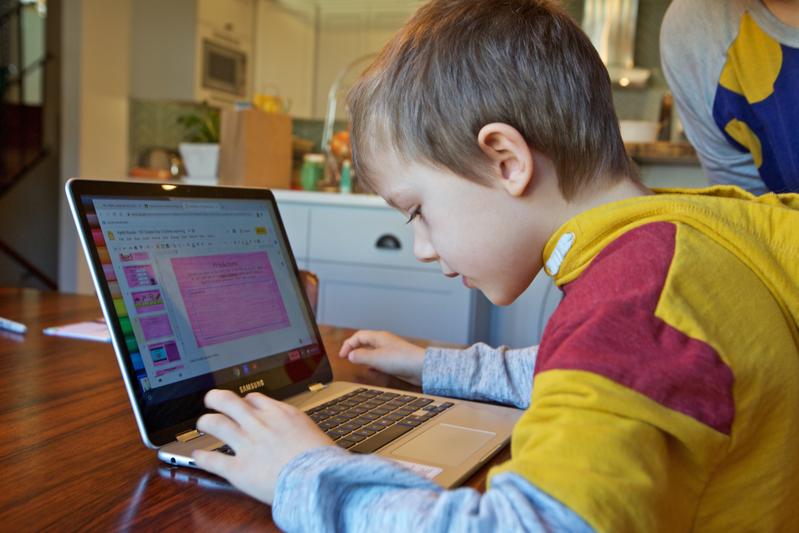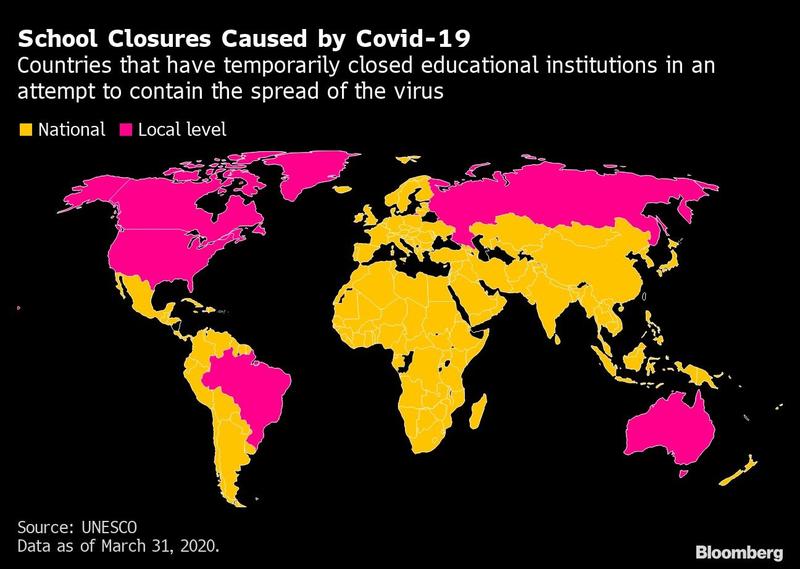 In this March 17, 2020 photo, Keith Bucks works at home remotely during an online class assignment from his first grade class at Arco Iris Spanish Immersion School in Beaverton. (CRAIG MITCHELLDYER / AP)
In this March 17, 2020 photo, Keith Bucks works at home remotely during an online class assignment from his first grade class at Arco Iris Spanish Immersion School in Beaverton. (CRAIG MITCHELLDYER / AP)
For David Krieger’s kids in south Florida, screens were a weekend treat. Now, every day is iPad-appropriate.
The big worry now is that the surge in screen time will outlast the quarantine as children develop new habits
The family’s schedule tries to cap the fun time on screens for the two kids to an hour between their educational activities, both also on electronic displays: a Zoom reading class, and an online drawing session. But the limit never sticks. With two working parents, “it is a necessity,” Krieger says.
As stay-in-place orders to contain the spread of the coronavirus globally keeps 1.5 billion school children home, restricted screen time is becoming a thing of the past. Across the world, from the Krieger kids to Mila, 9, in Paris, who loves attending classes on Zoom, and Ruby, 5, in London, who’s now a whiz at Minecraft, children are spending more time on their screens than ever before.
“It’s not ideal; we try to limit, but hell, without teachers it’s impossible to fill the days,” said Rachel Wilson, Ruby’s mother, a business writer who lives near Greenwich Park in southeast London.
While in the past, potential consequences -- especially for child development and mental health -- drove parents to seek out electronics-free schools and put time limits on their children’s screen exposure, with COVID-19, those concerns have fallen by the wayside. The big worry now is that the surge in screen time will outlast the quarantine as children develop new habits.

Children are re-purposing many apps and tools that weren’t meant for them, like Zoom, or games like Fortnite
Collins, whose firm advises companies from Lego A/S and Nintendo Co. on kid-tech applications
“Parents have temporarily lost the battle of screen time, but they can keep control,” said Serge Tisseron, a Paris-based psychiatrist, who studies the screen-time impact on kids. “They can choose -- there’s quality and trash available. This crisis will maybe bring one good thing: a sharp increase in content and selection.”
Dylan Collins, chief executive officer of UK-based startup SuperAwesome and a partner at Hoxton venture capital, says kid tech, “which wasn’t in the DNA of Silicon Valley, is going to make a giant leap forward -- education tech will benefit enormously; content-moderation tools for parents; chats will have to create many more functionalities for teens and kids.”
He cited the example of Epic Games, the company behind Fortnite, that’s integrating games and screen-sharing in Houseparty, the group video-chat app it acquired last year.
“Children are re-purposing many apps and tools that weren’t meant for them, like Zoom, or games like Fortnite,” said Collins, whose firm advises companies from Lego A/S and Nintendo Co. on kid-tech applications.. “All these tech companies are becoming family services, and they were not designed for that.”
Parents, meanwhile, are commiserating in Facebook groups and downloading apps to help them better manage their children’s screen time.
“You can feel and you can see that it’s an addiction,” Krieger said. “It’s better to not feed it.” Given a choice between screens and Lego, his children always pick screens, he said. “If there was no such thing as a screen, I think my kids could spend the whole day playing Legos, but since they know there’s a screen, they don’t want to.”
Michelle Clarke, a Massachusetts communications consultant, intends to reinstate her no-screens-in-the-bedroom rule for her teens once they go back to school.
“The only thing worse than having your kids exhibit device-addiction effects is experiencing it in shelter-at-home,” she said.
ALSO READ: School’s out, studying is in
Screen time for children “is bound to go up, doubling is even a conservative estimate,” said Simon Leggett, research director at Childwise, a market research firm in the UK.
“Online video, audio chats and online gaming are bound to increase, whether general socializing or discussing school work during the day,” he said.
Video-conferencing app Zoom has become widely popular, even among younger kids. The San Jose, California-based company’s stock has more than doubled from the US$62 closing price on its first day of trading last April, giving it a market value above US$40 billion.
Still, its security features remain a concern for some parents. This week, it was sued by a user who claims the company is illegally disclosing personal information. Last year, security firm Check Point notified the company that its systems could have allowed a threat actor to potentially identify and join active meetings. It said Zoom has addressed the issues since.
Screen-time worries remain largely an issue for higher-income countries, but its impact will eventually make it to other nations as standards of living rise, said UNICEF’s chief of policy, Jasmina Byrne.
“We can only speculate what this huge experiment will bring,” she said.
Last November, the World Health Organization said “sedentary screen time should be no more than one hour; less is better” for children below five. A University of Ottawa study in August, “Adolescent Brain Cognitive Development,” showed that children whose screen time remains under two hours a day, who exercise and who get between nine and 11 hours of sleep at night are “less impulsive.”
Nevertheless, there may be no going back. For Childwise’s Leggett, the big question is what “the new normal” will be.
READ MORE: Should schools close to fight virus? These places say no
“Societal habits will have to change in the long term,” he said. “I don’t see everything going back to normal, so new habits and skills picked up now by children are likely to continue at some level in some form in the future.”


